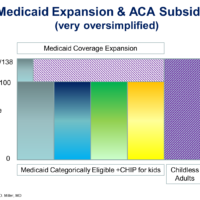In 2005 I started writing a book about health reform. As I was working on it, the structure and framework of the U.S. healthcare system kept shifting. I am now returning to work on this book, with the new working title, “Pivoting the U.S. Healthcare System: A Guide to Making Health Reform Work.” Below is a brief overview of the background about the book, which can also be found on my main website.
Comments, suggestions, and general inquiries about this project are welcome.
Overview – “Pivoting the U.S. Healthcare System: A Guide to Making Health Reform Work”
In my very first class in medical school, one of the first things the Professor said was, “Half of what we’re going to teach you is wrong. We just don’t know which half.” That admission is not something you will hear in political or policy pronouncements, even though in the rapidly evolving U.S. healthcare systems situations change, preliminary data is corrected, projections turn out to be wrong in meaningful ways, and “solutions” fix problems but also lead to new ones.
To provide people with a framework for improving the quality of care and controlling costs for themselves and their communities in this shifting world, this book will examine important ideas, issues, and trends, and the steps individuals can take to help achieve better health, access, and affordability. To do that, I will provide my synthesis of observations and information focusing on policy, political, scientific, and medical changes that are building upon one another. Thus, the book will not be an academic treatise, nor adhere to specific ideological, philosophical or political lines. Rather, it will reflect what I have learned in in more than 25 years of clinical, scientific, and health policy work, and my vision for achieving a better, stronger, more vibrant, and healthier healthcare system.
Long Look Forward
In June 2003, I was invited to address the Presidents of the State Medical Societies about “The Future of the US Healthcare System.” To help these physician leaders see the future more clearly through murky waters, I discussed how the trajectories of the major US healthcare programs (including Medicare and employment-based insurance) were leading to greater transparency and accountability for both clinical and economic outcomes. I then described a future where clinicians and providers would be responsible for the outcomes their care was producing, how payments would be tied to those outcomes, and how documenting those outcomes would be facilitated by electronic medical records and population-based analytical systems.
The reaction of the assembled physician leaders was one of dismissive disbelief. This was 2003. The world had come through Y2K unscathed, the dot-bomb recession was over, and the stock market was rising every week. Their primary question was ‘who will pay us to put in electronic medical records and to provide information about quality and costs?’ They didn’t believe my answer that those who wanted the information – such as health insurance companies and government agencies – would pay them to provide data and information about quality and costs. Those reactions were not unreasonable at the time, since I suspect most of this group was planning to retire within the next 10 years. (This was before the Great Recession turned their 401k accounts into 101k amounts.) However, while 2003 was generally a time of great uncertainty for the U.S. healthcare system, the year ended with the passage of a new law – the Medicare Modernization Act (MMA) – that included the new Medicare prescription drug benefit, and it was the first of several major laws driving fundamental transformation of the US healthcare systems.
Slow Turns
The 2003 passage of the MMA, the 2008 election of President Obama, the 2009 stimulus law (ARRA) that included the HITECH Act to support the implementation of electronic health records, and the 2010 passage of the Affordable Acre Act (ACA, or ObamaCare), have all promoted significant changes in the U.S. healthcare system. But since it is a huge and extensively connected but disjointed set of enterprises, turning the U.S. healthcare system is a slow process. Even policy focused physicians and senior health managers have been slow to accept or react to those changes. For example, in March 2009, I gave a Grand Rounds presentation at a hospital in Boston. Like my 2003 presentation to the Medical Society Presidents, I described a future with greater transparency and accountability, and the increased use of electronic health systems – particularly since the HITECH Act had become law the month before. The responses included a “rebuttal” from the Canadian-born Department Chair arguing for a single payer system, and a Resident who felt that the Geisinger model in Danville, PA wasn’t replicatable or relevant because – unlike most of the rest of the U.S. – Geisinger dominates its geographically insulated area.
But the more things change, sometimes they don’t. For example, I recently heard about a senior manager at a large integrated health system that refused to consider planning for the implementation of the ACA’s many provisions: First, Congress would repeal it. Then, it wouldn’t be implemented because Mitt Romney would win the 2012 election. And lastly, the Supreme Court would overturn the entire law. Of course, none of those things happened, so this large health system is now playing catch-up with their regional competitors. Similarly, in early 2014 I spoke with the physician leadership from a state that has not embraced improvements in their clinical care systems or changing incentives for physicians, hospitals, or patients to improve the quality of care or control spending. Their attitudes reflected a strong desire to maintain their status quo of autonomy, and particularly to not be held accountable (or responsible) for their patients’ clinical outcomes or the health of their communities. Basically they had healthcare delivery and insurance structures that hadn’t changed much since the 1980s, and such physician-centered care is much better for physicians than patient-centered care.
Health Reform Pivots at the Local Level
While my 2003 presentation to the Medical Society Presidents was in many ways a nexus for the work I’d been doing for more than 15 years, it also led me to start writing a book that had the working title “Fixing the US Healthcare System.” The 2008 election of President Obama (and the subsequent passage of the ACA/ObamaCare) led me to change the title to “Making Health Reform Work.”
Now in mid-2014, with many of the major components of the ACA having begun to be implemented – and their effects starting to be seen – I’ve returned to the book and the pieces I’ve been writing for almost 10 years. With the dramatic shifts that have occurred in that time, I’ve pivoted the book’s focus to explore more directly the important changes occurring at the local level and within healthcare delivery. Therefore, I’ve also changed the working title to “Pivoting the U.S. Healthcare System: A Guide to Making Health Reform Work.”
Goal of the Book
The goal of the book will be to provide readers with insights and greater understanding of how to evaluate and influence the rapidly changing healthcare world that encompasses delivery, financing, public health, and information technology – particularly at the local and personal level. The book will explore how initiatives at the local level are what will primarily improve the health of people and communities in the coming years. Specifically, while ObamaCare and governmental activities are changing the framework and the contours of the playing field, how local leaders, organizations, and communities are allocating their resources, setting their priorities, and improving their practices involving health benefits, clinical services, and public health activities are what will most dramatically effect the lives of people and communities.
The book will enable and empower people to alter and accelerate those important changes based upon their personal and local perspectives by working with different groups to make improvement more meaningful for them and their communities. This local multi-stakeholder engagement and alignment is increasingly recognized as crucial for improving healthcare quality and controlling costs: Large employers, insurance companies, and government programs now appreciate that they are not large enough to drive major changes in any market or at any provider organization. Similarly, large hospitals, health systems, payers, and public health agencies increasingly understand that their work and goals are interconnected so that their actions needs to be aligned, and at times even directly coordinated.
Physicians are also an important group to include in this process since physicians (and other clinicians) are primary guides for patients in making healthcare decisions, and greatly influence healthcare spending and quality.[1] And of course patients – and their indirect advocates in the media, government, non-profits, and foundations – need to be part of these intertwined dialogues and decision-making. The bottom, middle, top, left, and right conclusions all indicate that in the struggle against rising healthcare costs and burdens of disease and disability brought on by aging populations and other factors, united we can succeed, but divided we shall continue down the same failing path.
—
p.s. To see an old version of the working summary click “Making Health Reform Work.” The latest summary and outline are on my whiteboard and computer. Please contact me if would like more information about my progress, focus areas, and conclusions.
[1] As an old axiom states, “the most expensive piece of medical technology is the pen in the physician’s hand.” Today, that prescribing and referring pen is being replaced with a keyboard, a mouse, and a touchscreen, but the effect is similar, even as electronic medical records and systems are raising their own concerns about costs and quality.


